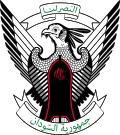Revolutionary Command Council for National Salvation
This article includes a list of general references, but it lacks sufficient corresponding inline citations. (February 2017) |
| History of Sudan | ||||||||||||||||||
|---|---|---|---|---|---|---|---|---|---|---|---|---|---|---|---|---|---|---|
 | ||||||||||||||||||
| Before 1956 | ||||||||||||||||||
|
||||||||||||||||||
| Since 1955 | ||||||||||||||||||
|
||||||||||||||||||
| By region | ||||||||||||||||||
| By topic | ||||||||||||||||||
| Timeline | ||||||||||||||||||
The Revolutionary Command Council for National Salvation (RCCNS-Sudan) was the governing body of Sudan following the June 1989 coup.[1] It grew out of the collaboration between the Sudanese military and the National Islamic Front.[2] It was the authority by which the military government of Sudan under Lt. Gen. Omar al-Bashir exercised power.
Al-Bashir was the Chair of the Council, as well as Prime Minister, Defense Minister and Commander-in-Chief of the Sudanese Armed Forces.[1] The rest of the council consisted of fourteen military officers, all of whom were involved in and associated with the coup.[3]: p. 2 Therefore, no regulations about the selection and tenure of its members were declared to the public.
The RCCNS exercised legislative as well as some executive authority. It appointed committees to draft various legal decrees. The RCCNS did not publish any rules of procedures over its deliberations.
It banned political activity, arrested opposition members and closed down newspapers.
The RCCNS dissolved itself in October 1993, and its powers devolved to the President and the National Legislature of Sudan.[4] This resulted in a majority of the power remaining with President al-Bashir.[3]: p. 131
Sources
- Helen Chapin Metz (ed.). "Government". A Country Study: Sudan. U.S. Library of Congress. Retrieved 2007-05-12.
- "Sudan's President Bashir". Profiles. BBC News Online. 2020-02-11. Retrieved 2027-08-18.
{{cite web}}: Check date values in:|accessdate=(help); Cite has empty unknown parameter:|dead-url=(help)
References
- ^ a b Cowell, Alan (July 1, 1989). "Military Coup In Sudan Ousts Civilian Regime". The New York Times. Retrieved February 19, 2017.
{{cite news}}: Cite has empty unknown parameter:|dead-url=(help) - ^ T. Abdou Maliqalim Simone (1994). In Whose Image? Political Islam and Urban Practices in Sudan. University of Chicago Press. p. 64. ISBN 0226758702.
- ^ a b Burr, J. Miller; Collins, Robert (2003). Revolutionary Sudan: Hasan Al-Turabi and the Islamist State, 1989-2000. Brill. ISBN 9004131965.
- ^ Long, David; Reich, Bernard, eds. (1995). The Government and Politics of the Middle East and North Africa. Westview Press. p. 344. ISBN 0813321263.
